Theory & Simulation
Plasma is a complex state of matter involving multiple parameters. Theoretical calculations related to plasma sciences are important input tools for conducting successful experiments. However, such theoretical calculations involve deep understanding of physics and mathematics which call for high end computing facilties. IPR has a dedicated team of scientists working on theory and simulations for basic plasma understanding and its applications. To support this work, IPR has also setup a high end petaflop computing facility named "ANTYA". A few of the activities undertaken at IPR are listed below:
Tokamak & Fusion Reactor Studies
Numerical Simulation of the Effect of Pellet Injection on ELMs: Numerical simulation studies of the dynamical be-havior of edge localized modes (ELMs) are done under the influence of repetitive injection of pellets. In our nonlinear 2-fluid model the ELMs are excited by introducing a parti-cle source in the confinement region and a particle sink in the edge region. The injection of pellets is simulated by pe-riodically raising the edge density in a pulsed manner. We find that when the edge density is raised to twice the normal edge density with a duty cycle (on time-off time) of 1:2, the ELMs are generated on an average at a faster rate and with re-duced amplitudes. These changes lead to significant improve-ments in the plasma beta indicative of an improvement in the energy confinement due to pellet injection. Concurrently, the plasma density and temperature profiles also get signifi-cantly modified. A comparative study is made of the nature of ELM dynamics for different magnitudes of edge density enhancements. The relative impact on ELMs from resonant magnetic perturbations compared to pellet injection in terms of changes in the plasma temperature, density, location of the ELMs and the nonlinear spectral transfer of energies are also thought through.
Displacement Damage Study in Tungsten and Iron for Fusion Neutron Irradiation: Displacement damage in tungsten and iron are studied using the TALYS-1.8 code and molecu-lar dynamics simulations. The TALYS-1.8 code is used to predict the energy spectra of recoils. The MD simulations of self-recoils of up to 200 keV damage energies are carried out to predict the number of Frenkel pairs in iron and tung-sten using the LAMMPS code. Time evolution of vacancies and interstitials are studied. The results of MD simulations are used to calibrate the constant parameters of the Arc-dpa method. The displacement damage cross section of tungsten and iron are calculated for the neutron irradiation of up to 15 MeV energy with the NRT and Arc-dpa approaches. The dpa (Arc-dpa) value at the first wall location of EU DEMO reaches 1.19 dpa/FPY and 0.93 dpa/FPY in iron and tungsten, respectively. Similarly, dpa values in iron and tungsten are also predicted at different neutron effluence using the NRT and Arc-dpa mechanism.
Kinetic Particle simulation in a global toroidal geometry: The gyrokinetic toroidal code has been upgraded for global simulations by coupling the core and scrape-off layer regions across the separatrix with field-aligned particle-grid inter-polations. A fully kinetic particle pusher for high frequency waves (ion cyclotron frequency and beyond) and a guiding center pusher for low frequency waves have been implement-ed using cylindrical coordinates in a global toroidal geom-etry. The two integrators correctly capture the particle orbits and agree well with each other, conserving energy and canon-ical angular momentum. As a verification and application of this new capability, ion guiding center simulations have been carried out to study ion orbit losses at the edge of the DIII-D tokamak for single null magnetic separatrix discharges. The ion loss conditions are examined as a function of the pitch angle for cases without and with a radial electric field. The simulations show good agreement with past theoretical re-sults and with the experimentally observed feature in which high energy ions flow out along the ion drift orbits and then hit the divertor plates. A measure of the ion direct orbit loss fraction shows that the loss fraction increases with the ion energy for DIII-D in the initial velocity space. Finally, as a further verification of the capability of the new code, self-consistent simulations of zonal flows in the core region of the DIII-D tokamak were carried out. All DIII-D simulations were performed in the absence of turbulence
Fundamental Plasma Studies
Electric Field Filamentation and Higher Harmonic Gener-ation in Very High Frequency Capacitive Discharges: The effects of the discharge voltage on the formation and nature of electric field transients in a symmetric, collision-less, very high frequency, capacitively coupled plasma are studied us-ing a self-consistent particle-in-cell (PIC) simulation code. At a driving frequency of 60 MHz and 5 mTorr of argon gas pressure, the discharge voltage is varied from 10V to 150V for a fixed discharge gap. It is observed that an increase in the discharge voltage causes filamentation in the electric field transients and to create multiple higher harmonics in the bulk plasma. Correspondingly, higher harmonics, up to 7th harmonic, in the discharge current are also observed. The power in the higher harmonics increases with a rise in the discharge voltage. The plasma density continues to increase with the discharge voltage but in a nonlinear manner, whereas, the bulk electron temperature decreases. Meanwhile, the electron energy distribution function evolves from a Maxwellian at lower discharge voltages to a bi-Maxwellian at higher dis-charge voltages.
Coupling of Drift Wave with Dust Acoustic Wave: A drift wave is a prominent mode of a magnetized plasma of inho-mogeneous density. It plays an important role in the transport of particles, energy, and momentum perpendicular to the am-bient magnetic field. The frequency of this mode is governed by the inhomogeneity scale length and is much lower than the typical homogeneous plasma modes involving ions and electrons. In this work, the possibility of coupling of this par-ticular mode with the low frequency modes of a dusty plasma medium is considered. The drift wave has been found to satu-rate at Large ky (perpendicular wavenumber) in a magnetized plasma with weakly correlated dust species mainly due to the shielding by polarization drift of ions. However, when dust particles are strongly correlated, the drift wave converts into a transverse shear wave at large ky.
Influence of Select Discharge Parameters on Electric Field Transients Triggered in Collision-less Very High Frequency Capacitive Discharges: Self-consistent particle-in-cell simu-lations are carried out to investigate the effect of discharge voltage, driving frequency, and the extent of the electrode gap on the formation of electric field transients. The shape of the electron energy distribution function into the bulk plasma and the nature of the mode transition in plasma density are presented for the driving frequency range of 27.12 MHz to 80 MHz. The present results, taken in conjunction with our pre-vious study that only looked at the driving frequency depend-ence in collision-less capacitive Argon discharges, provide a comprehensive and detailed account of the dynamics of such discharges over a multi-parameter operational space.
Plasma flow equilibria in 2D cylindrically symmetric ex-panding magnetic field: A steady-state plasma flow exiting through an expanding magnetic field is studied by means of 2D particle in cell numerical simulations. The effects of change in the localized plasma source region dimension and the associated plasma transit length in an upstream, uniform-magnetic- field region were examined, simulating cases with different axial lengths of the dielectric plasma source region, distinct from the location of physical expansion. Axial poten-tial profiles at various radial locations show development of a stepwise axial potential drop, producing plasma (ion) accel-eration in the corresponding regions. For a narrow source re-gion with a long pre-expansion flow region, non-monotonic potential variation is recovered where ion phase-space scat-ters show the trapped region and signatures of chaotic ion trajectories and possible pre-expansion ion heating. Consid-ering a relevance of the studied flow equilibria to the thrust generation schemes for space propulsion, a formal estimate of thrust values associated with the plasma outflow is also done for the cases simulated.
Multiple Steady State Co-Rotating Dust Vortices in Stream-ing Plasma: The 2D vorticity–stream function hydrodynamic model is applied to dust clouds electrostatically confined in an unbounded and streaming plasma. The vortex flow struc-ture of the volumetrically driven dust cloud is analyzed sys-tematically for different aspect ratios (ARs) of the bounded dust domain, exploring linear and nonlinear regimes of flow for a range of the kinematic viscosity. These results show the interplay between inertial and diffusive transport processes involving structural changes in dust vortex flow that develops asymmetry and shows a regular sequence of structural bifur-cations at threshold kinematic viscosity corresponding to a change in the AR value by nearly an integer. Agreement with many experimental observations is recovered, where the gen-eration of newer self-similar multiple co-rotating vortices is observed. The exclusive dependence of subsequent structural transitions on the flow domain AR is analyzed based on the properties of numerical solutions. These nonlinear solutions allow understanding of the underlying nonlinear character-istics of self-similar co-rotating vortices in experiments and their behavioral similarities with various relevant complex driven–dissipative natural systems.
Dynamics of a Toroidal Pure Electron Plasma using 3D PIC Simulations: Nonlinear dynamics of toroidally con-fined, initially cold, collisionless pure electron plasma has been numerically simulated in a tight aspect ratio, axisym-metric device, confined using a toroidal magnetic field, us-ing a 3D3V particle-in-cell code PEC3PIC. A set of three numerical experiments are conducted by loading the toroidal electron cloud at varying radial distances from the central axis at the vertical midplane, and a comparative analysis of the progression of cloud dynamics and particle transport in the three experiments is carried out. In each experiment, the cloud is seen to initiate toroidal Diocotron oscillations with the following interesting features: (i) initial nonlinear reshap-ing and density peaking, (ii) elliptical orbital path in the po-loidal cross section along with chirp or rotational frequency dynamics and the increase and decrease in the peak density of the filled electron cloud, (iii) cross-field transport and par-ticle loss, and (iv) the measured wall probe signals showing close similarity to experimental signals. It is demonstrated that relatively better confinement of electrons in the toroidal configuration is achieved by loading the initial plasma at the vertical midplane, close to the inner wall of the chamber, sup-porting the mean-field theoretical predictions. For all cases, the density distribution profiles in the (r, θ)and (r, z) planes of the cylindrical coordinate system (r, θ, z) have consistent peaked density central profiles. The time dependency of the dominant frequencies of the dynamics, obtained from wall probe data using Hilbert–Huang transformation and win-dowed Fourier transformation, suggests toroidicity induced low poloidal number m (~1 - 12)coupling and dynamical chirping.
Lane Formation in Driven Pair-Ion Plasmas: Lane formation dynamics of driven 2D pair-ion plasmas is investi-gated in underdamped cases. Extensive Brownian dynamics simulation is performed to study the behavior of the system in the presence of both constant and time-varying external electric fields. Lanes are found to form when like particles move along or opposite to the applied field direction. The lane order parameter has been implemented to detect phase transition. For the constant external field case, investigations are performed at different field strengths, to analyze the phase transition from a disordered to a lane state. It is observed that in this case, the electric field strength must exceed a critical value above which lanes are formed distinctly. For the case of the oscillating electric field, the frequency of the external oscillating field is found to control the lane formation phe-nomenon. It is observed that if the frequency of the external field exceeds a critical value, the system exhibits a transition back to the disordered state. A simple method for calculating the critical field strength provides quantitative agreement be-tween the calculated and simulated values of the critical field strength for the case of the constant external electric field. The calculated value of the critical frequency agrees qualita-tively with our simulation results for the oscillating external electric field case.
Effect of transverse beam size on the wakefields and driver beam dynamics in plasma wakefield acceleration schemes: Wakefields driven by a relativistic electron beam in a cold homogeneous plasma are studied using 2D fluid simulation techniques. It has been shown that in the limit when the transverse size of a rigid beam is greater than the longitudinal ex-tension, the wake wave acquires a purely electrostatic form, and the simulation results show a good agreement with the 1D results published before. In the other limit when the transverse dimensions are equal to or smaller than the longitudinal extension, the wake waves are electromagnetic in nature, and 2D effects play a crucial role. Furthermore, a linear theoretical analysis of 2D wakefields for a rigid bi-parabolic beam has also been carried out and compared with the simulations. It has also been shown that the transformer ratio, which is a key parameter that measures the efficiency in the process of acceleration, becomes higher for a 2D system (i.e., for a beam having a smaller transverse extension compared to the longitudinal length) than the 1D system (i.e., for a beam having a larger transverse extension compared to the longitudinal length). Furthermore, including the self-consistent evolu-tion of the driver beam in the simulation, we have seen that the beam propagating inside the plasma undergoes transverse pinching, which occurs much earlier than the longitudinal modification. Due to the presence of transverse dimensions in the system, the 1D rigidity limit given before in literature gets modified. We have also demonstrated the modified rigidity limit for the driver beam in a 2D beam–plasma system.
Driven electrostatic phase space vortices in a 1D weakly dissipative Vlasov-Poisson system: The effect of collisions on driven electrostatic phase space vortices is analyzed by means of Eulerian simulation for two different collision mod-els. It was demonstrated recently that in the absence of colli-sions, at late times, steady state phase space vortices manifest to form a plateau in the resonant region of the particle ve-locity distribution function, due to trapping of particles sup-porting multiextrema giant phase space vortices (PSVs). In the presence of collisions, over long time, this multiextrema plateau are found to smooth out, since collisions drive the velocity distribution toward Maxwellian, irrespective of how weak the collisions are as long as they are non-zero. In these conditions, kinetic processes and collisionality are found to be in competition, and the evolution of the plasma is found, therefore, to be a result of nontrivial combination of these two effects. An attempt has been made by means of numeri-cal simulations to study the effect of weak collisionality on the electrostatic driven phase space vortices with two types of collision operators: (1) Bhatnagar–Gross–Krook (Krook) col-lision operator, where the colliding particles can be treated as isolated pairs and, (2) Fokker–Planck (FP) type collision op-erator (Zakharov–Karpman) in one dimension, where many weak collisions lead to particle diffusion in velocity space. It is shown that depending on the collision model used, the nature of smoothing in velocity space of giant PSVs results in qualitatively very different phase space structures. However, irrespective of the collision model used, excess density frac-tions over 10% are retained.
Nonlinear Plasma Theory & Simulation
Coherent Nonlinear Oscillations in Magneto-hydrody-namic Plasma: Single fluid magneto-hydrodynamic (MHD) equations have been studied through direct numerical simula-tions using pseudo-spectral methods in two as well as three spatial dimensions. At Alfven resonance, a reversible peri-odic exchange of energy between kinetic and magnetic vari-ables is observed. The oscillations are identified as nonlinear dispersion-less Alfven waves that have been predicted earlier on theoretical grounds but not observed in large scale nu-merical simulations. A systematic study of their occurrence for various initial conditions and a range of Alfven velocities is carried out. An analysis based on a finite mode representa-tion of the incompressible single fluid MHD equations in two spatial dimensions reproduces the essential features of these oscillations.
Collective Dynamics of Globally Delay-Coupled Complex Ginzburg-Landau Oscillators: The effect of time-delayed coupling on the collective behavior of a population of glob-ally coupled complex Ginzburg-Landau oscillators is inves-tigated. A detailed numerical study is carried out to study the impact of time delay on various collective states that include synchronous states, multi-cluster states, chaos, amplitude-mediated chimeras, and incoherent states. It is found that time delay can bring about significant changes in the dynami-cal properties of these states including their regions of existence and stability. In general, an increase in time delay is seen to lower the threshold value of the coupling strength for the occurrence of such states and to shift the existence domain toward more negative values of the linear dispersion parame-ter. Further insights into the numerical findings are provided, wherever possible, by exact equilibrium and stability analy-sis of these states in the presence of time delay
Simulation of the Internal Kink Mode in Visco-Resistive Regimes: The numerical simulation results of the nonlinear evolution of the (1,1) internal kink mode in the presence of various kinds of equilibrium plasma flows. The present stud-ies are carried out in the framework of a two fluid model to extend our past investigations done with a reduced magneto-hydrodynamic (RMHD) model. Two-fluid effects are found to significantly influence the mode dynamics in a number of different ways. In the linear regime diamagnetic effects in combination with flows provide a synergistic stabilizing influence that also carries over to the nonlinear regime. In addition one observes novel symmetry breaking phenomena in the linear growth rates as well as in the nonlinear saturated states of the mode. Our study also explores the influence of strong viscosity on the mode evolution and finds interesting modifications in the real frequency of the mode in the linear regime.
Solitary and Shock Wave in Magnetized Collisional Pair-Ion Plasmas: The effect of ion–ion collision on the dynamics of nonlinear magneto-sonic wave in a magnetized pair-ion plasma consisting of positive and negative ions has been studied. The external magnetic field is situated perpendicular to the wave propagation. Two fluid model is used to describe the dynamics of positive and negative ions. Lagrangian trans-formation technique is used to carry out the linear and non-linear analysis. Linear analysis yields the dispersion relation of magneto-sonic wave in pair-ion plasmas. In small ampli-tude limit, Korteweg-de Vries Burgers’ (KdVB) equation has defined the nonlinear propagations of magneto-sonic wave. Ion–ion collisions are the source of dissipation in the system and also the origin of the Burgers’ term in KdVB equation. This Burgers’ term in KdVB equation is the source of the shock structures in pair-ion plasmas. Analytical and numeri-cal analysis reveals that the wave exhibits the solitary wave in absence of collisions. In presence of collisions, the wave exhibits both oscillatory and monotonic shock structures de-pending on the balance between dispersion and dissipation of the system. For weak dissipation, as compared to dispersion, oscillatory shock structure is formed and in reverse case, nonlinear wave exhibits monotonic shock wave.
Stationary Langmuir structures in a relativistic current car-rying cold plasma: Nonlinear stationary structures formed in a cold plasma with immobile ions in the presence of a rela-tivistic electron current beam have been investigated analyti-cally in the collisionless limit. These are cold plasma version of the relativistic Berstein-Greene-Kruskal (BGK) waves. The structure profile is governed by the ratio of maximum electrostatic field energy density to the kinetic energy density of the electron beam (κ). It is found that, in the linear limit (κ<<1), the density, electric field, and velocity vary harmoni-cally in space, whereas for large values κ, the fluid variables exhibit an-harmonic behavior
Laser-Plasma Interaction
Beyond the Conventional Collisional Absorption of Laser Light in Under-Dense Plasma: A Particle-In-Cell Simula-tion Study: Collisional absorption of laser light in an under-dense plasma is studied by particle-in-cell (PIC) simulation with Monte Carlo binary Coulomb collisions between charge particles. For a given plasma thickness of a few times the wavelength of 800 nm laser, fractional absorption (α) of the laser light due to Coulomb collisions (mainly between elec-trons and ions) is calculated at different electron tempera-ture Te with a total velocity v = (vth2 + v02/2)1/2 dependent Coulomb logarithm ln (v), where vth and v0 are thermal and ponderomotive velocity of an electron. In the low-temperaure regime (Te 15 eV), it is found that α increases with in-creasing laser intensity I0 up to a maximum corresponding to an intensity Ic, and then it drops (approximately) obeying the conventional scaling of α ~ I−3/20 when I0 > Ic. Such a non-conventional increase of α with I0 in the low intensity regime was demonstrated earlier in experiments, and recently explained by classical and quantum. Here, for the first time, we found this nonconventional collisional laser absorption by PIC simulation, thus bridging the gap between models, simulations, and experimental findings. Moreover, electron energy distributions naturally emanating during the laser in-teraction (in PIC simulations) are found to be anisotropic and non-Maxwellian in nature, leading to some deviations from the earlier analytical predictions.
Excitation of Kdv Magnetosonic Solitons in Plasma in the Presence of an External Magnetic Field: A new mechanism for direct laser energy coupling to heavier ion species in the presence of an external magnetic field has been illustrated. It has been shown that at higher amplitude, the ion disturbances form magneto-sonic solitons. A 2D particle-in-cell simu-lation for an incident laser beam normal to an over-dense plasma target in the presence of an external magnetic field has been carried out for this purpose. The external magnetic field is chosen such that the heavier ions remain unmagnet-ized but the lighter electron species get magnetized at the laser frequency. For conventional lasers of ~1 μm wave-lengths, the magnetic field requirement satisfying the afore-mentioned condition turns out to be of the order of several hundreds of kilo Tesla. This requirement goes down by one order if pulsed CO2 lasers with wavelengths of ~10 μm are employed. At present, magnetic fields of several kilo Tesla have already been generated in the laboratory. Keeping this in view, the simulations have been carried out for the pulsed CO2 laser parameters. It is shown that the ion heating is en-hanced considerably in the presence of an external magnetic field. Furthermore, it is shown that at a higher intensity of the laser, the ion disturbances acquire higher amplitude to excite Korteweg–de Vries magnetosonic solitons. The solitons, as expected, propagate stably for several thousands of ion plas-ma periods. However, subsequently, they are seen to develop transverse modulations which grow with time.
Asymmetric electron cloud from laser-driven cluster nano-plasma: A nano-cluster ionized by a femto-second pulse of wavelength larger than the cluster size sets up an electron cloud that oscillates with respect to the ion cloud. In experi-ments, a linearly polarized pump pulse sets up the dipole and the polarization of the probe pulse that comes after a prescribed time is varied, and the differential changes in the measured absorption gives a direct measure of the asym-metry and ellipticity in the permittivity. We perform fully relativistic two-dimensional electro-magnetic particle-in-cell simulations and our results show that orthogonally polarized pump-probe pulses absorb about 18% less compared to the parallel case at the peak of the linear plasma resonance which corroborate experiments at TIFR.
Relativistic Self-Focussing and Self-guiding of laser pulse:Propagation of laser pulse in plasma is determined by the critical power Pc. When the power of laser pulse exceeds this threshold value Pc, it expels the electron in its path which leads to modulation in the electron density. The electron den-sity modulation in turn modifies the refractive index of the plasma in such a way that relativistic self-focussing and self-guiding is made possible. Very often this parameter regime for laser and plasma density is ignored for generation of mo-noenergetic electron beam via laser wakefield acceleration. However, recent experiments, have demonstrated production of monoenergetic, 35 MeV electron bunch using 3 TW pulse (a0=1) and high density 5.8×1019cm-3 plasma. OSIRIS PIC simulations have been carried out in this parameter regime to decipher the role of various physical mechanisms (specifi-cally direct laser acceleration) responsible for production of the surprisingly narrow energy electron bunch.
Ideal MHD simulation of laser generated plasma plume: Numerical simulation using three dimensional ideal magne-tohydrodynamics equations have been carried out to study the evolution of pulsed laser generated plasma plume flowing in a direction perpendicular to the applied external magnetic field (0.13 T). Gross features like formation of cavity and col-lapse of cavity into a jet beam as observed in experiments are well reproduced in the simulation. Simulation shows that initially when the dynamic beta of plasma is high, the plasma expansion is unimpeded and the magnetic field is advected with the flow. The plasma expansion leads to compression and bending of the external magnetic field lines at the plas-ma plume boundary. The increased magnetic pressure at the boundary of plasma plume decelerates the plume expansion and gives rise to a reverse shock in the expanding flow. This leads to formation a cavity surrounded by a shell of shocked plasma. The radial expansion is then halted when the plasma pressure and the magnetic pressure becomes comparable. Fi-nally, the cavity collapses into a jet like flow.

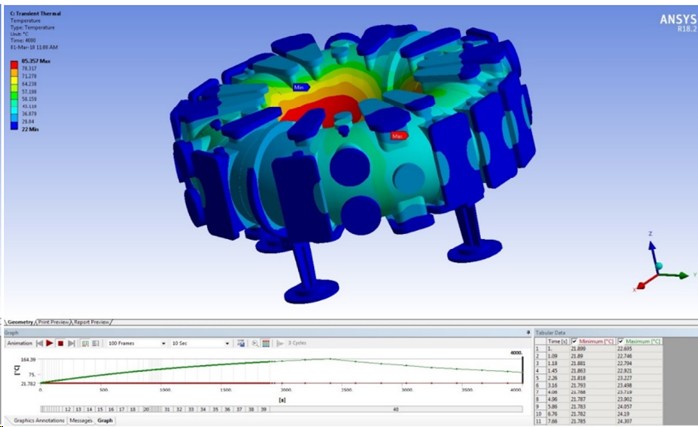
Thermomechanical Analysis of RFQ and ADITYA baking in FEM
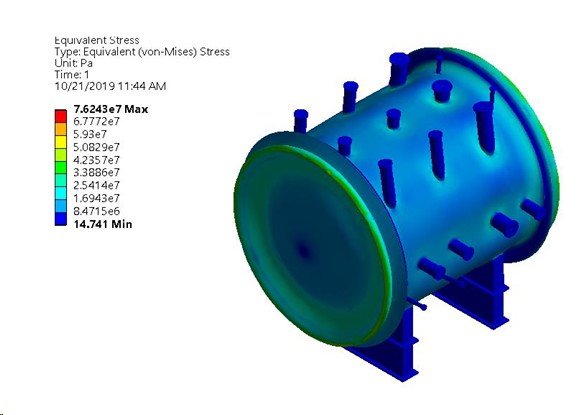
Structural Analysis of Pressure vessel
Recent Design and Analysis:
Radiation analysis of SMARTEX-C:
- To estimate the maximum temperature on the vessel due to source
- CFD analysis with different schemes for cool down
Flue Gas System :
- Analyzed for flue gases evaporated due to interaction of molten metal and inert gas due to plasma.
- Temperature Distribution around the chamber.
- Cool down scheme for the chamber as per the requirement of process.
Magnetic force analysis:
- With the help of Maxwell code.
- Model with 16 TF (Toroidal Field) coils.
- Intercoil structure also considered.
- Single coil with all the different electromagnetic forces

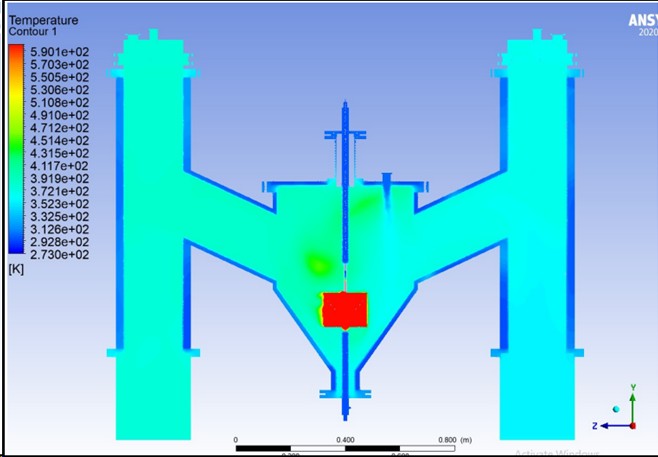
Thermal Hydraulic Analysis using Computational Fluid Dynamics of SMARTEX-C and of Flue Gas System
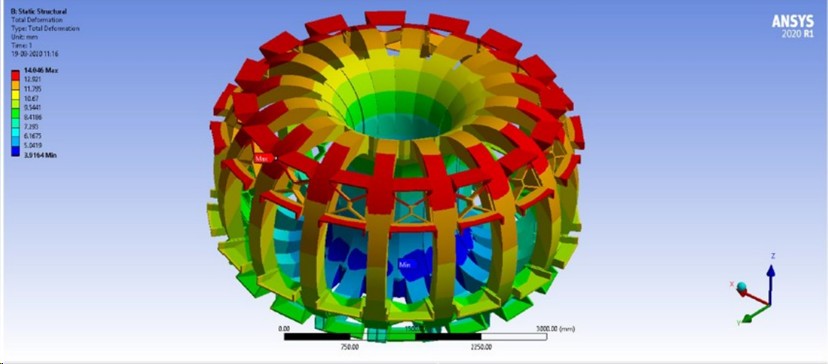
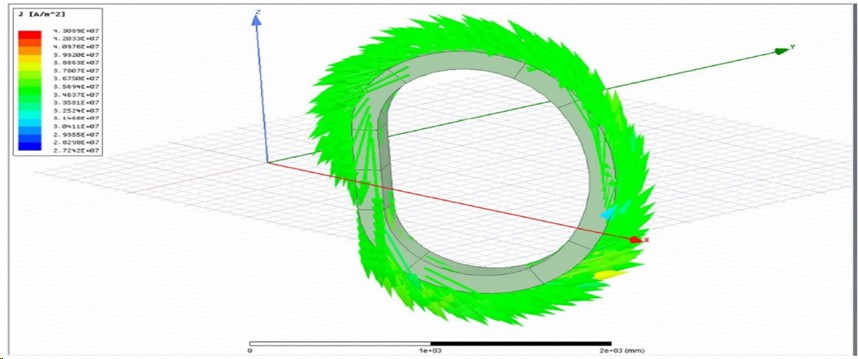
Electromagnetic Analysis of SST-1 Coil
Flooding Simulation
Simulation of flooding in urban areas
The modelling technique developed at IPR can simulate flooding scenarios based on available Digital Elevation Model (DEM) of urban areas, combined with rainfall data, to provide predictions of flooding levels in different areas.The recent work includes modelling of 2.5 km sq area of Vienna city on 1:1 scale and tested with imaginary dam break situation for 200 seconds runtime where a 100 m water height column is broke down and spread of water in city areas can be calculated at any point w.r.t. time. Full scale model of city is achievable and simulation is in process using Opensource software.
Case1: city area- 25_4 tile of Vienna city’s model has been taken from https://www.wien.gv.at/ma41datenviewer/public/
Results at point1 (300,2100, 5.1)

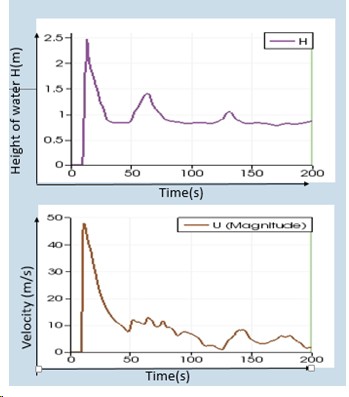
Modelling of Plasma Arc based Pulverised Coal Igniter:
Coal-air mixture enters through inlet and is activated by Plasma arc to generate intense flame. Temperature profiles during the process is shown in the animation:
Geometry

2D axi-symmetric Mesh

Modelling of Deflagration to Detonation Transition
- Deflagration flame is started by a small spark. As the flames move forward turbulences increase the rate of reaction which leads to the development of detonation wave.
- Obstacles are used to enhance the turbulence in the flow to speed up the process.
- Pressure profiles during the process are shown in the animation.
3D finite-difference time-domain (FDTD) simulations using an in-house code to simulate 3-D distribution of current density and heating in complex conductors carrying pulsed currents.


Current density magnitude & Temperature (deg-K)

Magnetic field at the mid-length ( 5 cm from the breech-end) at time 0.8 ms, obtained from 3D FDTD.
Current density magnitude & Temperature (deg-K)
Simulation and R&D Activities for Fusion Neutronics
Introduction
The ultimate goal of the nuclear fusion research is to produce power from D-T reactions. 80% of the energy in this reaction is carried by 14 MeV neutrons. These neutrons can be used in applications such as power production, tritium breeding, isotope breeding for medical & industrial applications, fissile fuel breeding, spent nuclear fuel burn-up etc. Simulation of the interactions of these neutrons from birth to end is an important task and requires dedicated tools such as radiation transport codes based on deterministic & stochastic approach, neutron activation codes, reactor models, geometry modelling and post-processing tools.
These activities can be broadly categorised into two parts:
Analysis Activities: Nuclear analysis of a fusion reactor is an important design activity for the safe operation of a reactor and fulfilment of regulatory limits related to nuclear radiation. It involves optimization of radiation shielding for radiation sensitive equipment & biological hazards, calculation of tritium breeding ratio (TBR), rad-waste calculation etc.
The figure below shows the total neutron flux distribution from a 2.76 MW DT fusion reactor calculated using a monte-carlo code:
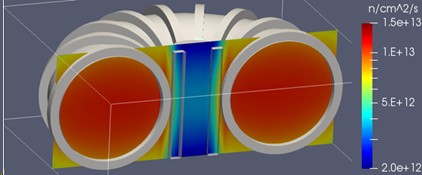
Neutronics tools development:
Monte-carlo radiation transport codes require accurate inputs about the system geometry. Engineering Computer-Aided Design (CAD) models are based on BREP (boundary representation) but monte-carlo codes requires CSG (Constructive solid geometry) which can only use analytical surfaces. A python-based algorithm has been developed to read CAD geometrical information from STEP format and convert it into analytical surfaces.
The figure below shows the 3D CAD model converted into CSG representation used in the monte-carlo analysis:

A preliminary study was performed to calculate the radio-isotope inventory in the blanket of a small fusion neutron source (FNS), where the reactor operates with a 50-50 composition of of D-T fuel. Results are given below:
Radio-isotope inventory in 1 kg of target material irradiated at the first wall of the FNS
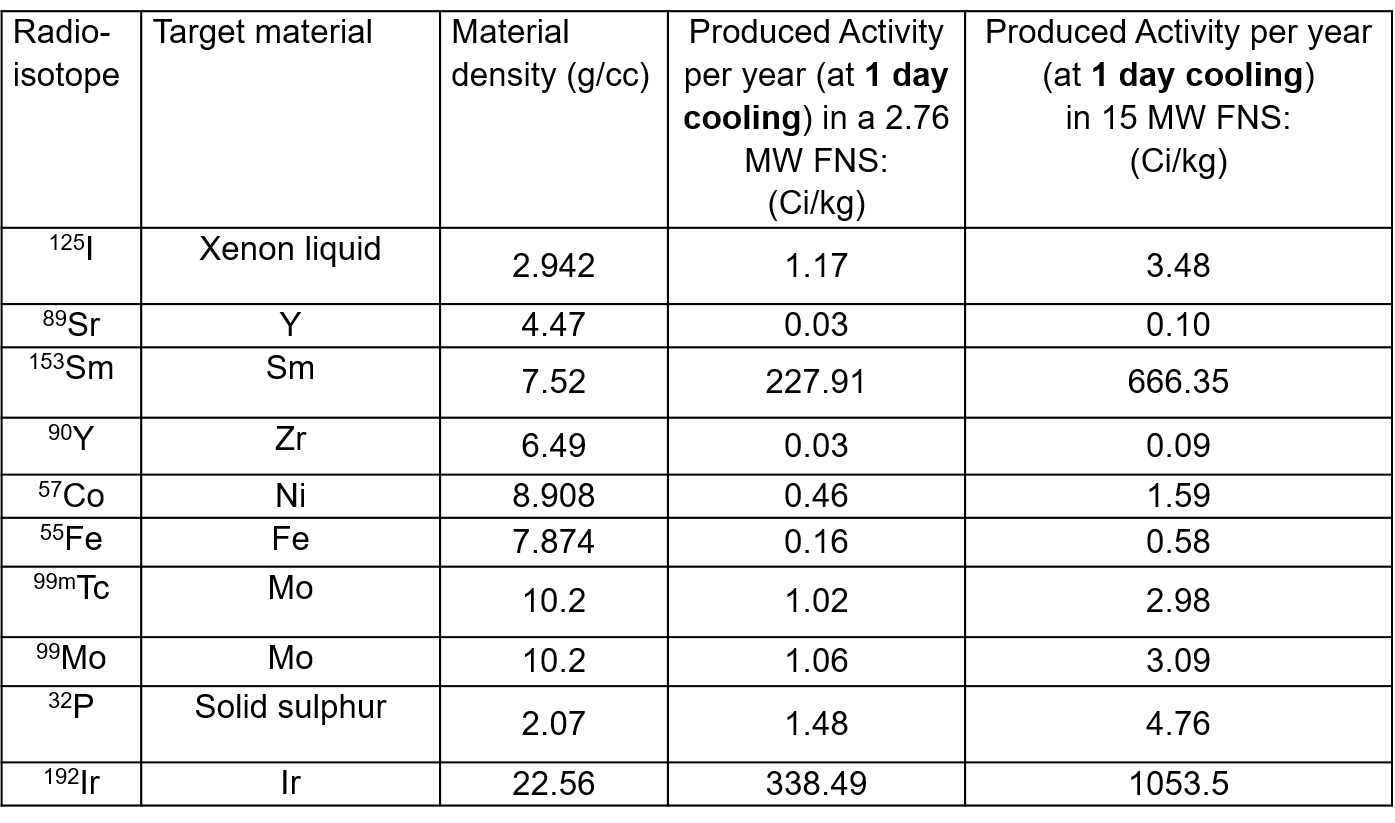
Recent Publications
1. IPR Technical Report TR-541 "Validation of Smartex-C Vacuum Vessel Heating Results with
FEM Radiation Analysis" Ritesh Kumar Srivastava, Manoj Kumar Gupta, Bharat R. Doshi,
Lavkesh T. Lachhvani, Manu Bajpai, Yogesh Yeole
2. Sunil bassi, S. K. Nema, A. Sanghariyat, C. Patil, P. V. Murugan and shashank chaturvedi, Numerical Simulation of Diesel Combustion Passing Through High Power Arc Region in a Plasma Fuel System, IPR/RR-1300/2021, July 2021
3. Bassi, S., Soni, S., & Chaturvedi, S. (2019). Effect of Fuel Distribution on the Onset of Detonation in Gaseous Octane Air Mixture. Defence Science Journal, 69(1), 31-36. https://doi.org/10.14429/dsj.69.12779
4. Sunil Bassi, Sanjay Kumar Soni, Shashank Chaturvedi, CFD simulations to study the effect of fuel droplet size and pre vaporization on the sustainability of detonation wave, IPR/RR-1230/2020, October 2020
Recent Publications: Conference Papers & Oral Presentations:
1. S. Bassi, S. Chaturvedi, Numerical Study of Deflagration to Detonation Transition in Pulse Detonation Engine with Octane-Air Mixture, 25th National Conference on Internal Combustion engines and Combustion, 15-17 Dec 2017, NITK Surathkal
2. Sunil Bassi, Manika Sharma, Shashank Chaturvedi, Numerical study of the Effect of Fuel Distribution on Single Shot Thrust in Pulse Detonation Engine Operating with Gaseous Octane-Air Propellant, Proceedings of the 7th International and 45th National Conference on Fluid Mechanics and Fluid Power (FMFP), 10-12 Dec 2018, IIT Bombay, Mumbai, India. FMFP2018-Paper No. 384
3. Sunil Bassi, Sanjay Kumar Soni, Manika Sharma, Shashank Chaturvedi, Numerical Simulations of the Detonation Wave Propagation Between Different Media, 6th National Symposium on Shock Waves, 26-28 Feb 2020, IIT Madras, Chennai.
Computational Fluid Dynamics (CFD) using OpenFoam framework
OpenFoam(OF) is a open-source code for CFD applications. The prime areas in which IPR is working on are combustion, acoustics and shock waves. The main topics covered under each area is shown in fig A. Customized solvers are either built or modified from existing OF libraries for each application. Other tools (mostly open-source) are used to meet the requirements of the work like CANTERA, SDTool box, python, matlab etc. OpenFoam solvers are installed in ANTYA HPC facility and scaling/performance studies have been performed for each application.

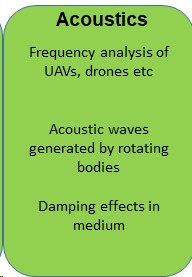

Figure A : area of expertise
Numerical simulations of Deflagration to Detonation Transitions (DDTs) : A customized OpenFoam solver has been developed by IPR to model combustion and DDTs in 2D/3D domains. Various studies have been carried out to predict the effect of DDT with the changes in geometry, obstacles (rings and shchelkin spiral) , spacing, blockage ratio, fuel equivalence ratio etc . The solver is tested with code-code benchmarking and published data
Brief capabilities of the code :
- both Pressure and Density NS Equations
- Chemistry and Thermo Solver
- Combustion progress variable (C) formulation
- Weller Flame Combustion model
- Ignition delay times (auto-ignition)
- Accurate Shock capturing
- Works reasonably well on coarse and unstructured grids
- validated against experimental data base (H2-air mixtures)
- Can be coupled with Lagrangian solvers (for fuel sprays)
- Currently usable for H2, methane, octane, propane and ATF/kerosene air mixtures
Potential applications : pulse detonation tubes, hydrogen detonation studies in nuclear containment, mining, methane –oxidizer rocket engines etc.

Pressure profile during Detonation to Deflagration transitions in a tube filled with octane-air mixture

Numerical simulation of the deflagration-to-detonation transition of iso-octanevapor in an obstacle-filled tube , Hu Ma et al , International Journal of spray and combustion dynamics
Frequency analysis of drone/UAV propellers :
rhoReactingFoam solver in OpenFoam is used to analyze CAD model of drone propeller (twin blade).Dynamic mesh options are utilized to rotate the propeller in air filled domain with turbulence models. The idea behind the analysis is to predict the acoustic frequencies generated by the blades at various distance , acoustic damping in the medium , amplitudes (or intensity) of the waves etc. The output data from the OpenFoam is coupled with python subroutine which calculates the Fast Fourier Transform of the pressure signals and plots the spectrogram of frequencies with time. The analysis is carried out for various RPMs, air speeds, turbulent conditions etc.
Frequency analysis of drone/UAV propellers :

Demo problem : Twin blade model rotating at constant 837 rad/s ( or ~8000 RPM )
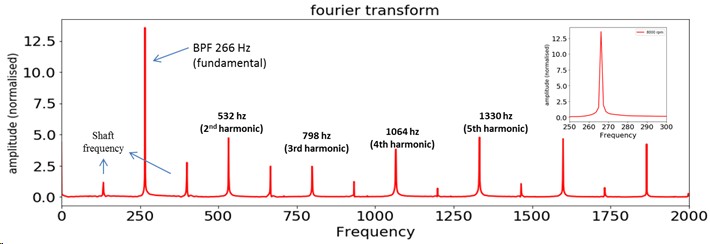
Computational Fluid Dynamics (CFD) using OpenFoam framework
Recent Developments:
Numerical simulations of blast induced damage in urban landscape : Accidental chemical explosions in urban areas pose a threat to humans as well as critical infrastructure. Impact of such accidents and the effect of blast waves in urban environments provide useful information to develop precautionary, preventive and mitigating measures. Computer based large scale simulations can be effectively used to predict these kind of blast scenarios in 3D city models. Modelling techniques developed at IPR can be used to simulate these scenarios either by CAD models or available DEM city models at very low cost as compared to various commercial software. The solver can also be used to study the impact of blast waves on various structures , humans, flora and fauna etc.

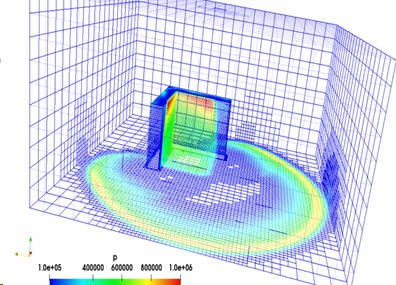
Demo problem : blast wave simulations on L shaped structure in 5mx5mx5m room dimensions
Laser Cluster Interaction – Coulomb explosion and energetic electron generation
Interaction of intense laser light with a cluster of many thousands of atoms or molecules may lead to creation of a high-density plasma (typically solid-like plasma density) and creation of energetic electrons, ions and x-ray photons on subsequent absorption of laser. Therefore this field is very interesting for particle accelerators and photon accelerators. We perform particle-in-cell (PIC) simulations, molecular dynamics simulations and simple model calculations to understand such energy absorption process. Movie shows outcome of such PIC simulation for a deuterium cluster of 2000 atoms in three dimensional space. An initially neutral cluster is getting ionized (meaning creation of plasma) first, once laser field (red, right top) reached a critical level. After that many electrons (white) absorb laser energy by non-linear process and leaves the cluster. Then bare-ionic background expands (blue) due to Coulomb repulsion between ions, often called Coulomb explosion. Coulomb explosion generates ions of near MeV energies.
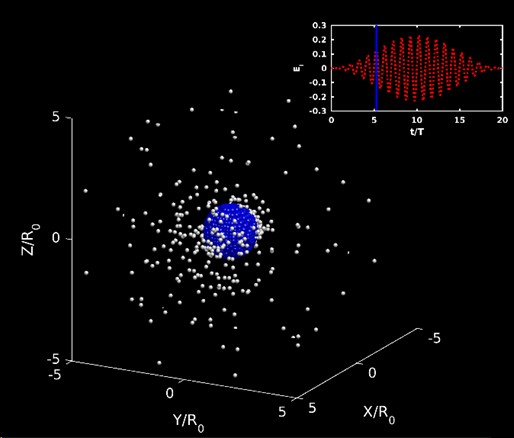
By Sagar Sekhar Mahalik and Mrityunjay Kundu – Basic Theory and Simulation Division
Reference:
1. S. S. Mahalik and M. Kundu, “On the resonance absorption in laser-driven deuterium cluster”, Eur. Phys. J. Spec. Top. (2021).
2. S. S. Mahalik, and M. Kundu, “Dynamical resonance shift and unification of resonances in short-pulse laser-cluster interaction”, Phys. Rev. A 97, 063406 (2018).
3. S. S. Mahalik, and M. Kundu, “Anharmonic resonance absorption of short laser pulses in clusters: A molecular dynamics simulation study”, Phys. Plasmas 23, 123302 (2016).
- Tokamak & Fusion Reactor Studies
- Fundamental Plasma Studies
- Engineering Analysis & Simulation
- Computational Fluid Dynamics (CFD)
- Laser Cluster Interaction

